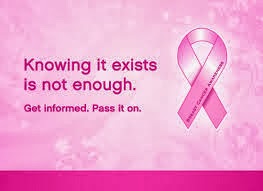October is Breast Cancer Awareness Month
October is Breast Cancer Awareness Month. Here at Uptown Smile we are passionate not only about your dental health, but also your overall health. Breast cancer is the most common cancer among American women, with the exception of skin cancer. Statistics state that about 1 in 8 (12%) women in the US will develop invasive breast cancer during their lifetime.
The American Cancer Society's estimates for breast cancer in the United States for 2013 are:
- About 232,340 new cases of invasive breast cancer will be diagnosed in women.
- About 64,640 new cases of carcinoma in situ (CIS) will be diagnosed (CIS is non-invasive and is the earliest form of breast cancer).
- About 2,240 new cases of invasive breast cancer
 were expected to be diagnosed in men in 2013. A man’s lifetime risk of breast cancer is about 1 in 1,000.
were expected to be diagnosed in men in 2013. A man’s lifetime risk of breast cancer is about 1 in 1,000. - Breast cancer incidence
 rates in the U.S. began decreasing in the year 2000, after increasing
for the previous two decades. They dropped by 7% from 2002 to 2003
alone. One theory is that this decrease was partially due to the reduced
use of hormone replacement therapy (HRT) by women after the results of a
large study called the Women’s Health Initiative were published in
2002. These results suggested a connection between HRT and increased
breast cancer risk.
rates in the U.S. began decreasing in the year 2000, after increasing
for the previous two decades. They dropped by 7% from 2002 to 2003
alone. One theory is that this decrease was partially due to the reduced
use of hormone replacement therapy (HRT) by women after the results of a
large study called the Women’s Health Initiative were published in
2002. These results suggested a connection between HRT and increased
breast cancer risk. - About 39,620 women in the U.S. were expected to die in 2013 from breast cancer, though death rates have been decreasing since 1989 — with larger decreases in women under 50. These decreases are thought to be the result of treatment advances, earlier detection through screening, and increased awareness.
- For women in the U.S., breast cancer death rates are higher than those for any other cancer, besides lung cancer.
- Besides skin cancer, breast cancer is the most commonly diagnosed cancer among American women. Just under 30% of cancers in women are breast cancers.
- White women are slightly more likely to develop breast cancer than African-American women. However, in women under 45, breast cancer is more common in African-American women than white women. Overall, African-American women are more likely to die of breast cancer. Asian, Hispanic, and Native-American women have a lower risk of developing and dying from breast cancer.
- In 2013, there were more than 2.8 million women with a history of breast cancer in the U.S. This includes women currently being treated and women who have finished treatment.
- A woman’s risk of breast cancer approximately doubles if she has a first-degree relative (mother, sister, daughter) who has been diagnosed with breast cancer. About 15% of women who get breast cancer have a family member diagnosed with it.
- About 5-10% of breast cancers can be linked to gene mutations (abnormal changes) inherited from one’s mother or father. Mutations of the BRCA1 and BRCA2 genes are the most common. Women with a BRCA1 mutation have a 55-65% risk of developing breast cancer before age 70, and often at a younger age that it typically develops. For women with a BRCA2 mutation, this risk is 45%. An increased ovarian cancer risk is also associated with these genetic mutations. In men, BRCA2 mutations are associated with a lifetime breast cancer risk of about 6%; BRCA1 mutations are a less frequent cause of breast cancer in men.
- About 85% of breast cancers occur in women who have no family history of breast cancer. These occur due to genetic mutations that happen as a result of the aging process and life in general, rather than inherited mutations.
- The most significant risk factors for breast cancer are gender (being a woman) and age (growing older).
At this time there are more than 2.8 million
breast cancer survivors in the United States. (This includes women
still being treated and those who have completed treatment.)
We offer hope for the fighters, peace for the survivors & prayers for the taken.
citations:
cancer.org
breastcancer.org
American Cancer Society

No comments:
Post a Comment